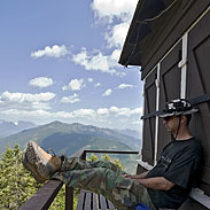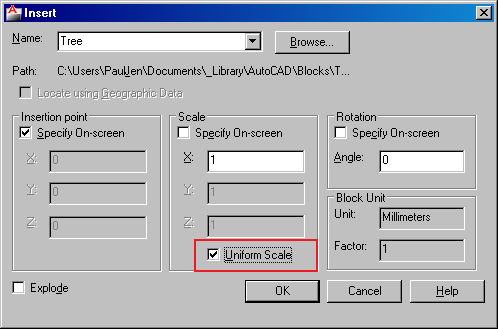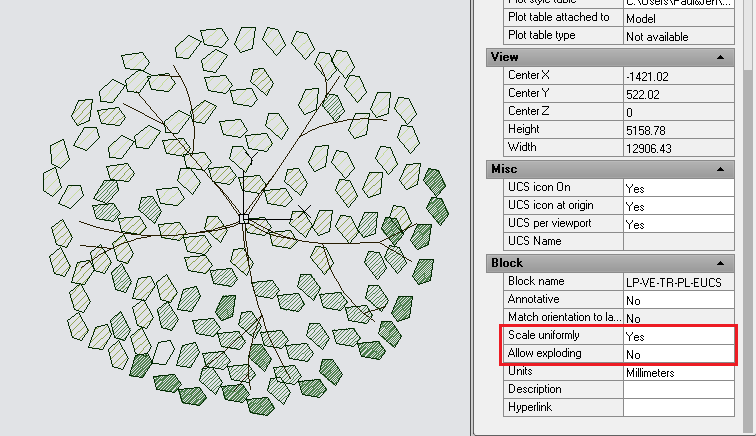Landscape Architecture for Landscape Architects › Forums › PROFESSIONAL PRACTICE › Non-Uniform Block Detection
- This topic has 1 reply, 7 voices, and was last updated 10 years, 9 months ago by
 Chris Whitted.
Chris Whitted.
-
AuthorPosts
-
September 24, 2013 at 1:46 pm #154065
 CalicoParticipant
CalicoParticipantI use AutoCAD’s data extraction to generate accurate plant counts. These projects frequently involve many thousands of plants over very large commercial and multifamily sites, each plant with several attributes. Going back to counting by hand would be a slow death… and this is one of the reasons why I use AutoCAD.
Normally the data extraction function works well (very steep learning curve a few years ago), although this morning I received the awful warning that at least one block is not uniformly scaled. Uggh. This is disturbing for obvious reasons, as the warning calls into question the accuracy of the plant count. When I define a plant block I make sure that it scales uniformly and can’t be exploded to avoid this exact problem: the data extraction function ignores attributes from non-uniformly scaled blocks. This particular file has several dozen plant blocks, and seems to be error-free. To the best of my knowledge all of the blocks I am using are uniformly scaled… but I’d like to rule this out and move on. Going through each block is of course possible via Properties in the block editor, but I’d hope that somebody here has figured out a shortcut.
Before I search for the needle in the haystack to find the bugger(s) that are not uniformly scaled… does anybody have a working lisp routine that can search a drawing to find any and all non-uniformly scaled blocks?
Thanks for your time.
September 24, 2013 at 8:04 pm #154077 Chris WhittedParticipant
Chris WhittedParticipantI don’t have a lisp routine, but I do have a couple of ideas.
Are the plant blocks the only ones in the file (ie, are you getting a false positive from a non-plant block)? Does the total number bcount result equal the data extraction result? Are all of the blocks on one layer, or do they contain multiple layers themselves (thinking of ways to isolate groups to check at once instead of individually)? You say you normally set them up so they can’t be scaled – does this mean that you have a different block for every size plant? If so, even if you select a group of different blocks/sizes, their scale property should still be 1. If you select a bunch of symbols on screen and look at the generic properties box (not the block editor), under the block reference section there is a scale property for x, y, and z. If all the symbols you have selected are correct and set to 1, these fields should be the same. If you have selected one of your problem blocks, one of the fields should say ‘varies’. That would give you a reduced selection set to search through – along the lines of a number between 1 and 100, is it more or less than 50, then 25/75, etc.
September 24, 2013 at 9:21 pm #154076 CalicoParticipant
CalicoParticipantThanks for the thoughts. I was able to brute-force a solution this morning similar to your approach above (perennials, trees, shrubs, etc., have unique layers), but need to figure out a lisp routine to get a solution more easily in the future. One &^%$* instance of one &^%$#^ block had a randomly huge z-value, which means that at some point I either the file became corrupted or I was drafting while high again. To answer your questions generally, each genus gets one block with a few attributes (code, container size, etc.), which means that all junipers look alike, all spireas look alike, etc., although each species or cultivar is usually a different diameter (I label each mass with a plant code). Each block is scalable (just not able to be exploded)… otherwise the drawing would be a complete mess with too many blocks to keep straight.
September 24, 2013 at 11:07 pm #154075 Andrew Garulay, RLAParticipant
Andrew Garulay, RLAParticipantWhy don’t you insert one of each plant block that is used in the drawing off to the side – all inserted at a scale of one. select them all and check the properties like Chris mentioned. That way you know if the flaw is within one of the blocks, or if a random block(s) somehow had one of the scale properties adjusted.
Are some of your plant blocks containing other blocks (nested)? … either purposely or accidentally? You could test that by copying those plant blocks, exploding them, and selecting them again to see if any blocks show up in your properties.
September 25, 2013 at 12:04 am #154074 J. Robert (Bob) WainnerParticipant
J. Robert (Bob) WainnerParticipantCalico…….Well, I can’t offer you any better solutions than others here on LAND8. During my LA career….I personally produced approx. 375 upscale multi-family projects (with all contract documents – including full Planting Plans & Plant Lists)….I counted ALL of the plants “by hand” on every project.
I was always up to my eyeballs with design projects…..so, making the transition from “hand drawing” to “autoCAD” just wasn’t possible. And, I didn’t wish to expand by hiring up younger LA’s who were proficient with autoCAD.
Yes, there were times when the “plant count” accuracy was an issue between myself and 1 or 2 of the Landscape Contractors bidding a project….but, nothing we weren’t able to work out. But, counting plants “by hand”….was definitely NOT fun.
Hope you find a good workable solution to your problem!
Regards,
Bob
September 25, 2013 at 12:36 am #154073 CalicoParticipant
CalicoParticipantAgain, I was able to solve the problem through the process of elimination and swearing (about 3 hours I won’t get back), and I did try something approximating your solution in the first paragraph. Those blocks were fine, so I knew that the problem was in an individual block and not global.
Thankfully, my blocks are not nested within other blocks, accidentally or otherwise, which would be a twisted way to ruin the newbie’s day and destroy a project budget in the process.
What I don’t understand is how (why?) this wonderful piece of software managed to change only the z-scale of one instance of one block set to scale uniformly in the middle of an apartment complex parking lot. Once I have some time I will write a lisp routine to run through every block in a set and return coordinates or other marker for every instance not uniformly scaled… although my hope is that somebody else already did so, allowing me to avoid wheel reinvention.
Cheers.
September 25, 2013 at 1:51 am #154072 J. Robert (Bob) WainnerParticipant
J. Robert (Bob) WainnerParticipantWell…..I really am old school…….and will remain so. I realize that the LA profession went the way of the “computer” years ago….but, there will ALWAYS be “issues”. Seems so many companies, the Stock Market, etc…end up with computer glitches. A member here on LAND8 just the other day, told me he had his lap top & thumb drive stolen….they had his entire Portfolio on them and he has no other copies. He should have had a “hard copy” or a “back up set” of his Portfolio.
Problems can arise if power goes out OR if your computer goes down. Then too, autoCAD is always coming up with newer version every year it seems….money, money.
Everyone needs to be SURE to back-up their project files…..on a “daily basis”…so, you don’t lose work.
Glad you were able to resolve your autoCAD problem!
September 25, 2013 at 5:54 pm #154071 Goustan BODINParticipant
Goustan BODINParticipantNo Lisp for you (still in the steep learning curve myself), but I have recently come across a couple of LISP libraries online.
Hope that helps…
September 25, 2013 at 11:42 pm #154070 Andrew Garulay, RLAParticipant
Andrew Garulay, RLAParticipant“Well one good thing about now vs. back in the day is that lisps are now accepted.”
Roseanne Roseannadanna
September 26, 2013 at 12:43 pm #154069 Robert AndersonParticipant
Robert AndersonParticipantThat is funny!
October 5, 2013 at 6:38 am #154068 Paul StaffordParticipant
Paul StaffordParticipantHi Calico
You’ve probably got this sorted now but if not…
I’m not sure why this has happened but how are you setting the blocks to scale uniformly? In the insert dialogue box…
…or in the block editor?
All my blocks are created to scale uniformly and not explode in the block editor and try as I might I couldn’t get them to be scaled non-uniformly. Something funny is obviously happening in the insertion process so might
I don’t know of a lisp to check for non-uniformly scaled blocks so can’t help with that. But I can recommned a program for your planting plans – PlantCAD. I’ve used it for 15 years and it works very well. It automates a lot of the processes that you’ve been doing. It’s got a trial version…give it a try.
Regards
Paul Stafford
October 5, 2013 at 10:15 pm #154067 CalicoParticipant
CalicoParticipantAs indicated earlier I solved the problem at hand a while back. I tried to replicate the original problem and have not been able to replicate it. I suspect that a random acad error was the culprit, although the file seems to be clean. I did find a few different .lsp routines on line similar to what I described above… but not exactly. If I feel motivated and absolutely can’t think of anything else to do I may modify one of those that performs the task described above. And yes, all blocks are inserted uniformly and not to explode, which was why this issue was so weird. I rarely insert plant blocks anyway, as they are already a part of my standard template. Thanks for the PlantCad suggestion.
October 6, 2013 at 1:09 am #154066 Paul StaffordParticipant
Paul StaffordParticipant -
AuthorPosts
- You must be logged in to reply to this topic.





